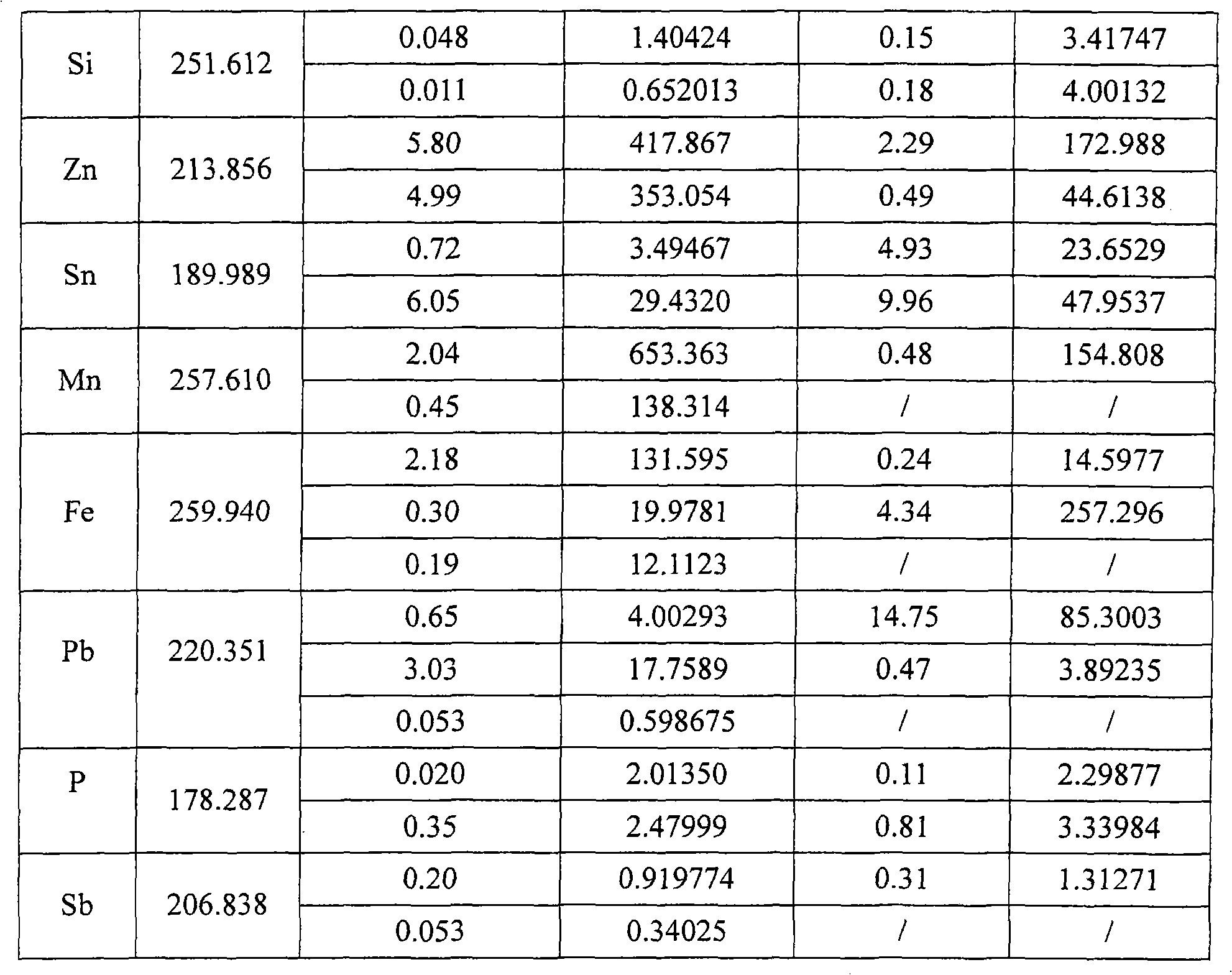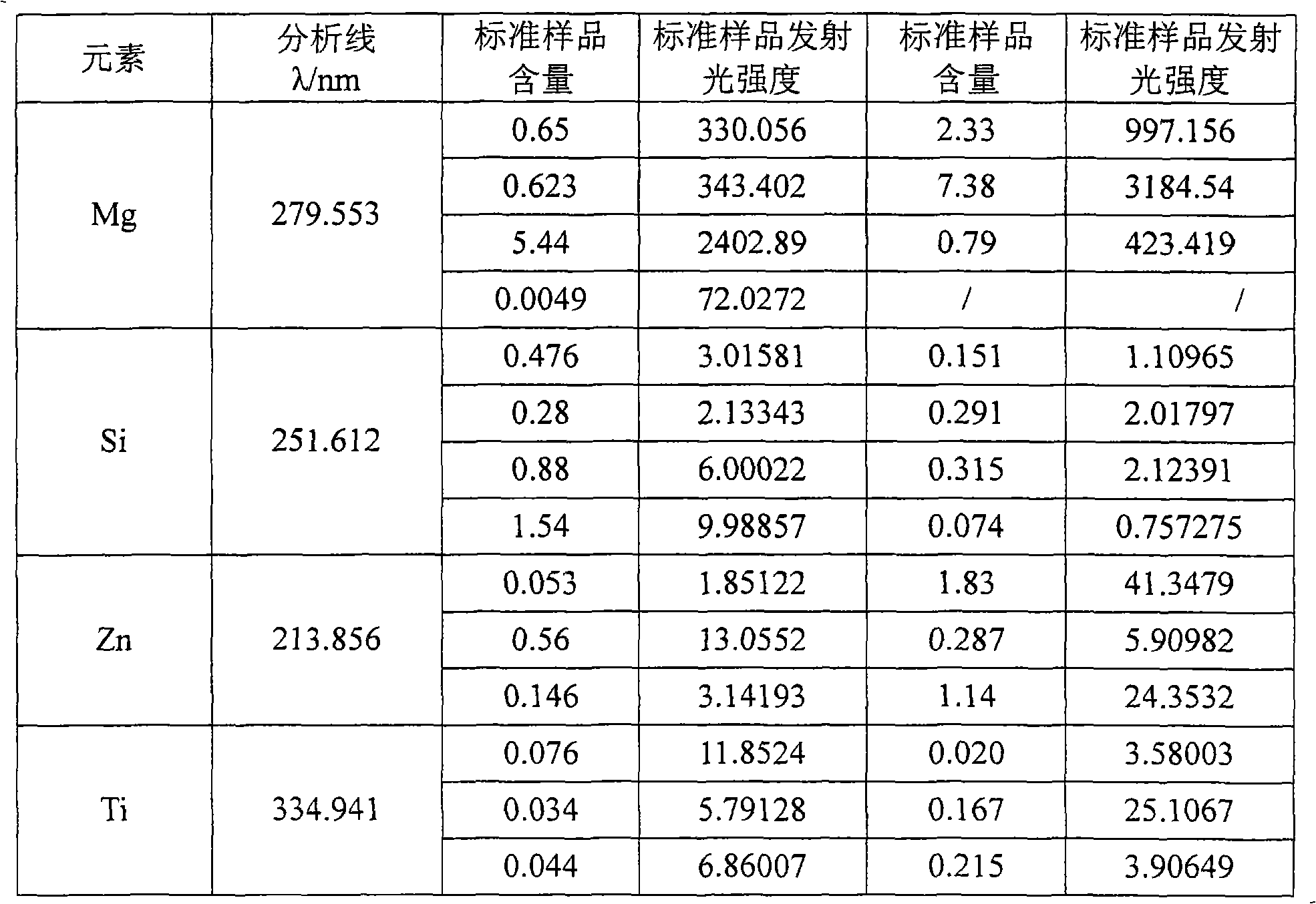Method for detecting element content in alloy or ore by utilizing ICP emission spectrometer
A spectrometer and alloy technology, which is applied in the field of detecting the content of various elements in alloys or ores, can solve the problems of poor control of accuracy, long detection cycle, and not necessarily high accuracy, so as to shorten the measurement cycle and achieve stable and linear detection results. wide range of effects
- Summary
- Abstract
- Description
- Claims
- Application Information
AI Technical Summary
Problems solved by technology
Method used
Image
Examples
Embodiment 1
[0027] The preparation of embodiment 1 copper alloy test solution
[0028]Weigh 0.1000g of the copper alloy sample, place it in a 100mL steel volumetric flask, add 10mL of hydrochloric acid solution (hydrochloric acid (ρ is 1.19g / mL): water = 1:1, volume ratio) 10mL, add dropwise hydrogen peroxide ( ρ is 1.10g / mL) 1-2mL; put the steel volumetric flask on the electric heating plate, heat and dissolve the sample at low temperature (100-300°C), wait until the sample is completely dissolved and bubbles appear, indicating that the hydrogen peroxide has been completely destroyed ; Take off the volumetric flask, cool it down, dilute it to the mark with distilled water, and shake it up to get the copper alloy test solution; if there is precipitation, perform dry filtration.
Embodiment 2
[0029] The preparation of embodiment 2 aluminum alloy test solution
[0030] Weigh 0.1000g of the aluminum alloy sample, place it in a 250mL polytetrafluoroethylene beaker, add about 2g of sodium hydroxide, inject a small amount of distilled water; When the aluminum alloy sample is almost invisible to the naked eye at the bottom of the liquid, it is considered to be completely dissolved), after standing still, remove the beaker, add nitric acid solution (nitric acid (ρ is 1.42g / mL): water = 1:2, volume ratio) 40mL, Transfer the solution into a 250mL tall beaker, add 2 drops of hydrogen peroxide (ρ is 1.10g / mL), wash the polytetrafluoroethylene beaker with distilled water 3-4 times, mix the washing liquid into the tall beaker, stir well, Place the tall beaker on an electric stove and heat to boil for about 30 seconds; remove the tall beaker, cool it down, transfer the solution into a 200mL volumetric flask, dilute to the mark with distilled water, shake well, and get the alumin...
Embodiment 3
[0031] The preparation of embodiment 3 low alloy steel test solution
[0032] Weigh 0.2000g of low-alloy steel sample and place it in a 100mL steel volumetric flask;
[0033] For CrMo-free steel, add 20mL of nitric acid solution (nitric acid (ρ is 1.42g / mL): water = 1:3, volume ratio), heat and dissolve the sample at low temperature (100-300°C), and wait until the sample is completely dissolved ( It is advisable that the test solution has large bubbles), add (50g / L) ammonium persulfate solution 10mL, boil until large bubbles appear, remove, cool, dilute to the mark with distilled water, shake well, and obtain a CrMo-free steel test solution;
[0034] For CrMo steel and tool steel: add mixed acid (sulfuric acid (ρ is 1.84g / mL): phosphoric acid (ρ is 1.69g / mL): water = 15:15:80, volume ratio) 10mL, low temperature (100-300°C ) and heat to dissolve. After the sample stops dissolving, slowly add about 1mL of nitric acid to destroy the carbides, continue to boil until smoking for ...
PUM
 Login to View More
Login to View More Abstract
Description
Claims
Application Information
 Login to View More
Login to View More - R&D
- Intellectual Property
- Life Sciences
- Materials
- Tech Scout
- Unparalleled Data Quality
- Higher Quality Content
- 60% Fewer Hallucinations
Browse by: Latest US Patents, China's latest patents, Technical Efficacy Thesaurus, Application Domain, Technology Topic, Popular Technical Reports.
© 2025 PatSnap. All rights reserved.Legal|Privacy policy|Modern Slavery Act Transparency Statement|Sitemap|About US| Contact US: help@patsnap.com



